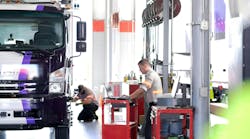To dance past driver turnover, carriers want to partner with shippers and receivers
Fleet managers who want to do the best by their drivers can only get so far alone.
What fleets can't do is be with drivers through every rough spot they hit on the road, from lousy truckstops to dangerous car drivers.
Many of the annoyances drivers say lead them to quit a carrier revolve around how they're treated at the dock - not on the road.
That situation, thankfully, may be about to change, if the Truckload Carriers Assn. (TCA) has anything to say about it.
Last fall, a group of TCA members met during the annual National Industrial Transportation League (NITL) meeting in San Diego to discuss the difficulties their drivers face at shippers' and receivers' docks.
For his part, NITL president Ed Emmett suggested in opening remarks to the convention that there should be more cooperation with trucking.
"It's time for the League to partner with the motor carrier industry to start solving some of the very real problems with inefficiency, driver retention, and the driver-treatment question," Emmett noted.
At their gathering, the carrier executives agreed that a big chunk of their driver-retention problem grows out of what happens - and doesn't happen- at the shipping and, especially, the receiving end of things.
The TCA group identified these sore spots for drivers as the main areas shippers and receivers could address: loading/unloading; waiting time (at the dock); driver count; driver sort/restack; delivery times; driver safety; lumpers; restrooms/phones/ food for drivers; and the simple expectation of respect.
The consensus of the executives held that solving these problems would both enhance equipment utilization and reduce driver turnover.
Declaring the theme of their mission for improvement was "It Takes Three to Tango," the TCA group agreed it needed to get receivers involved in the discussion for anything significant to happen.
Outlining a course of action, the fleets pinned down four projects worth pursuing:
1. Identifying the "best practices" of shippers regarded as having good distribution systems, such as Kellogg, Procter & Gamble, Mars, and Campbell's.
2. Establishing benchmarks, including cost of driver turnover; cost of waiting; cost to shippers for changing carriers (when a carrier drops them thanks to driver problems); and cost of reduced service when shippers change carriers.
3. Holding meetings between shippers, receivers, and carriers on a CEO-to-CEO or CFO-to-CFO basis to discuss identifiable efficiencies. Companies targeted for this included Hannaford, Wal-Mart, SuperValu, and Fleming Foods.
4. Conduct a survey of dry-van drivers similar to TCA's earlier study of reefer drivers.
The last item is already in the works. TCA has engaged Martin Labbe Associates, which conducted the reefer survey, to query van drivers on a number of critical issues.
The questions will include how much time they spend waiting to load and unload; how much time is consumed by actual loading/unloading; and what percentage of time they receive help at the dock.
Freight customers will want to pay attention to this survey, too, since drivers will also be asked to list both the "fairest" and "least fair" shippers/receivers they encounter.
Last, but certainly not least, drivers will be asked to rank how important some factors are to making their jobs better, including reductions in waiting times; attitudes of dispatchers; and attitudes of dock personnel.
Back in San Diego, the fleet executives agreed that all these issues will be part of the trucking industry debate on changes to hours-of-service regs.
The rationale to that point is simple. Having drivers drive instead of hanging around or loading trucks at docks would certainly help mitigate the issue of hours of service.
Or as one TCA member observed, "If drivers had wanted to unload trucks, they would have become lumpers." Now that's a tune every trucker would happily dance to.


